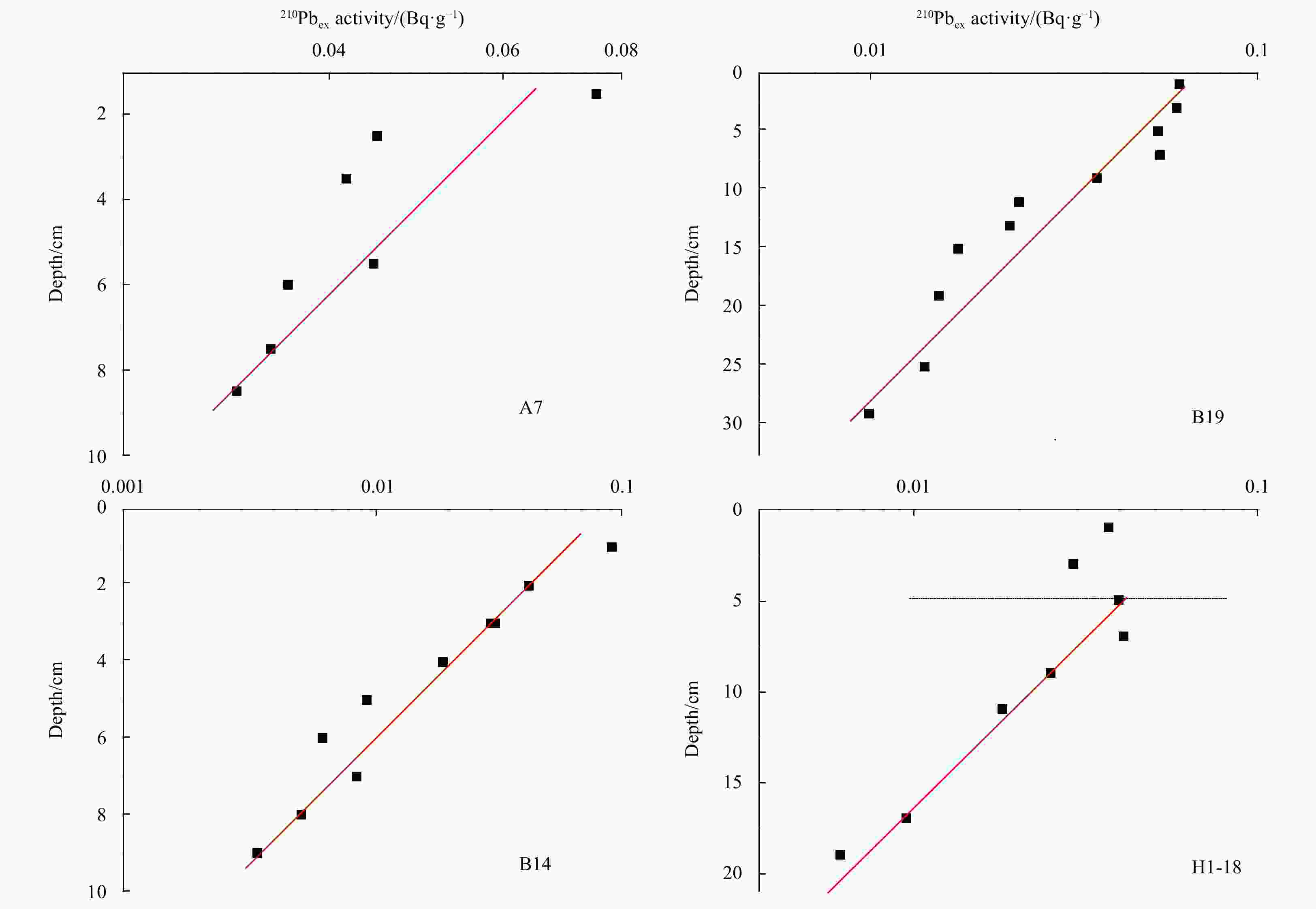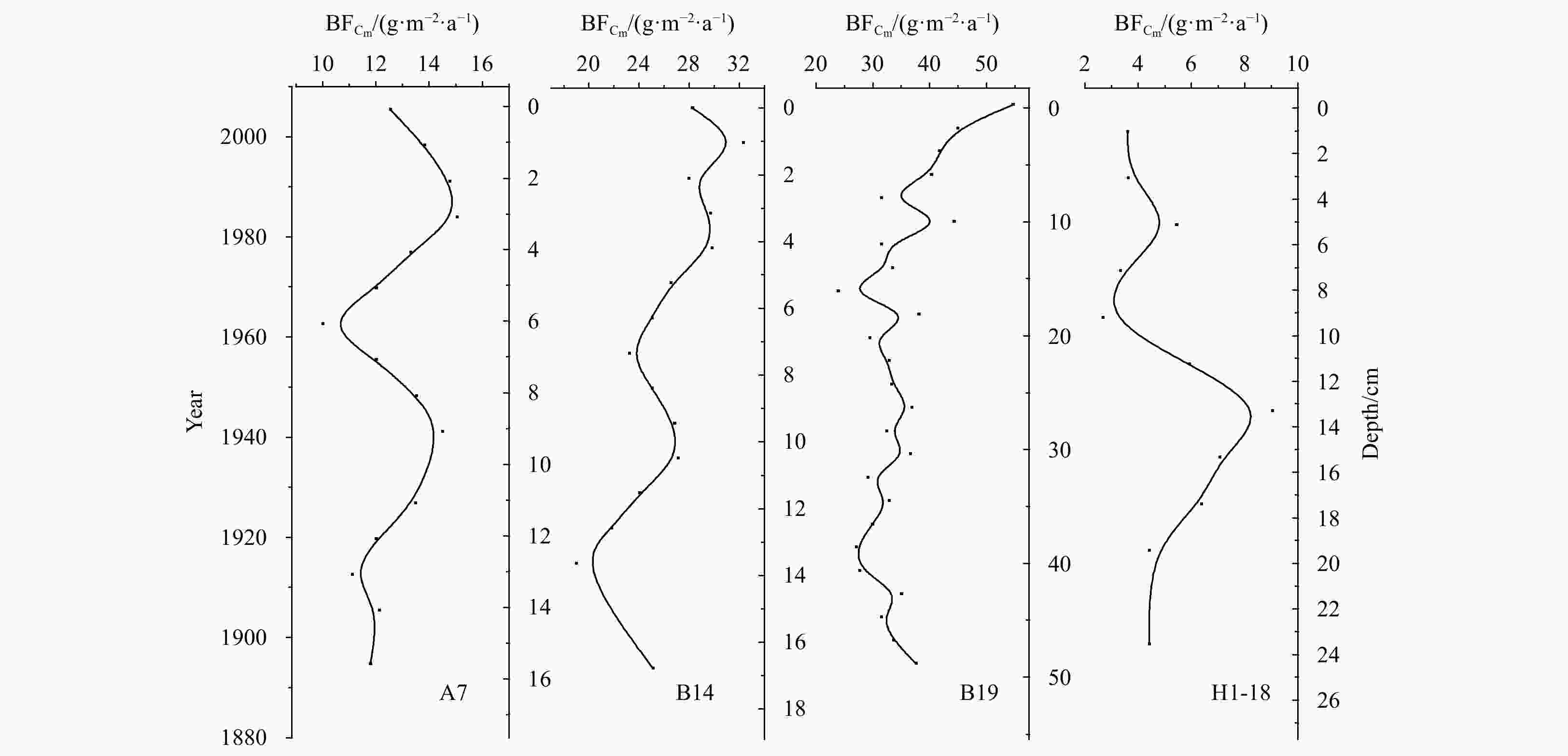Environmental factors affecting regional differences and decadal variations in the buried flux of marine organic carbon in eastern shelf sea areas of China
-
Abstract: To characterize environmental factors controlling decadal-scale variations in the buried flux of marine organic carbon (
${\rm{BF}}_{\rm{C_m}} $ ) in the eastern shelf sea areas of China (ECSS), four well preserved sediment cores collected from the central Yellow Sea mud (CYSM) area, the Yellow Sea Coastal Current (YSCC) area and the Changjiang River Estuary (CRE) were investigated in this study. In the CYSM, variations in${\rm{BF}}_{\rm{C_m}} $ were found to be dependent on variations in primary productivity and to exhibit a cyclical trend possibly related to fluctuations in the Pacific Decadal Oscillation (PDO) and the East Asian winter monsoon index (EAWM). In the YSCC,${\rm{BF}}_{\rm{C_m}} $ likewise depends on primary productivity. Prior to the 1950s, variations in${\rm{BF}}_{\rm{C_m}} $ were similar to that of the EAWM. After the 1950s,${\rm{BF}}_{\rm{C_m}} $ increased rapidly and exhibited maximum values in the surface layer, consistent with an increase in primary productivity caused by the input of terrestrial nutrients associated with China’s economic development. In the CRE, variations in${\rm{BF}}_{\rm{C_m}} $ were affected by several competing factors making it difficult to identify clear relationships between variations in${\rm{BF}}_{\rm{C_m}} $ and primary productivity. In contrast, long-term variability in${\rm{BF}}_{\rm{C_m}} $ is more similar to changes in the Changjiang River sediment load. Thus, it is speculated that the construction of dams along the Changjiang River may be the main cause of variations in${\rm{BF}}_{\rm{C_m}} $ in this area. Given the disproportionate effects of human activities on marine environments and decadal variations in${\rm{BF}}_{\rm{C_m}} $ in the ECSS, careful attention should be paid to regional differences in organic carbon preservation and environmental changes lest estimates of these values be made imprecise or inaccurate.-
Key words:
- marine organic carbon /
- buried flux /
- primary productivity /
- climate change /
- human activity
-
Figure 6. Temporal variations in the buried flux of marine organic carbon (
${\rm{BF}}_{{\rm{C}}_{\rm{m}}} $ ) and biological silicon (BSi). The triangle represents BSi, and the square represents${\rm{BF}}_{{\rm{C}}_{\rm{m}}} $ . BSi data are quoted from Yang et al. (2012).Figure 7. Decadal changes of the buried flux of marine organic carbon (
${\rm{BF}}_{{\rm{C}}_{\rm{m}}} $ ), Pacific decadal oscillation (PDO), East Asian winter monsoon index (EAWM) and Changjiang River Estuary sediment load. Raw data of PDO, EAWM and sediment load are cited from Yang et al. (2017), Huang (2015), and Wang et al. (2008), respectively.Table 1. Sedimentation rate, total nitrogen content (TN), total organic carbon (TOC), the ratio of carbon content vs. nitrogen content (C/N), and marine-derived organic carbon content (Cm) in cores
Station Water
depth/mSedimentation
rate/(cm·a–1)TN TOC C/N Cm Range/% Average/% Range/% Average/% Range Average Range/% Average/% A7 87 0.14 0.050−0.075 0.064 0.37−0.55 0.46 6.66−7.68 7.23 0.21−0.33 0.28 B14 80 0.15 0.124−0.171 0.140 1.05−1.52 1.28 8.06−11.34 9.19 0.37−0.63 0.51 B19 43 0.44 0.039−0.091 0.057 0.36−0.66 0.43 6.27−9.42 7.52 0.14−0.39 0.26 H1-18 63 0.22 0.038−0.050 0.043 0.56−0.79 0.67 12.57−17.56 15.41 0.04−0.12 0.07 -
[1] Cai Deling, Sun Yao, Zhang Xiaoyong, et al. 2014. Reconstructing a primary productivity history over the past 200a using the sediment organic carbon content and the stable isotope composition from the East China Sea and the Yellow Sea. Haiyang Xuebao (in Chinese), 36(2): 40–50 [2] Cao Yunyun, Xing Lei, Zhang Ting, et al. 2017. Multi-proxy evidence for decreased terrestrial contribution to sedimentary organic matter in coastal areas of the East China Sea during the past 100 years. Science of the Total Environment, 599–600: 1895–1902 [3] Carroll J, Zaborska A, Papucci C, et al. 2008. Accumulation of organic carbon in western Barents Sea sediments. Deep-Sea Research Part II: Topical Studies in Oceanography, 55(20–21): 2361–2371 [4] Chen Bin, Hu Limin, Deng Shenggui, et al. 2011. Organic carbon in surface sediments of the Bohai Bay, China and its contribution to sedimentation. Marine Geology & Quaternary Geology (in Chinese), 31(5): 37–42 [5] Dai Jicui, Song Jinming, Li Xuegang, et al. 2007. Geochemical characteristics of nitrogen and their environmental significance in Jiaozhou Bay sediments. Quaternary Sciences (in Chinese), 27(3): 347–356 [6] Dean W E. 1999. The carbon cycle and biogeochemical dynamics in lake sediments. Journal of Paleolimnology, 21(4): 375–393. doi: 10.1023/A:1008066118210 [7] Duan Lingyun, Wang Zhanghua, Li Maotian, et al. 2005. 210Pb distribution of the Changjiang estuarine sediment and the implications to sedimentary environment. Acta Sedimentologica Sinica (in Chinese), 23(3): 514–522 [8] Hu Limin, Shi Xuefa, Bai Yazhi, et al. 2016. Recent organic carbon sequestration in the shelf sediments of the Bohai Sea and Yellow Sea, China. Journal of Marine Systems, 155: 50–58. doi: 10.1016/j.jmarsys.2015.10.018 [9] Huang Jiansheng. 2015. Sedimentary record of anchovy population dynamics in the Yellow Sea and its response to climate change (in Chinese) [dissertation]. Xiamen: Xiamen University [10] Ingall E, Jahnke R. 1994. Evidence for enhanced phosphorus regeneration from marine sediments overlain by oxygen depleted waters. Geochimica et Cosmochimica Acta, 58(11): 2571–2575. doi: 10.1016/0016-7037(94)90033-7 [11] Jia Guodong, Peng Ping’an, Fu Jiamo. 2002. Sedimentary records of accelerated eutrophication for the last 100 years at the Pearl River estuary. Quaternary Sciences (in Chinese), 22(2): 158–165 [12] Jiang Shan, Liu Xiaodong, Xu Liqiang, et al. 2011. Potential application of biogenic silica as an indicator of paleo-primary productivity in East Antarctic lakes. Advances in Polar Science, 22(3): 131–142 [13] Kuehl S A, Fuglseth T J, Thunell R C. 1993. Sediment mixing and accumulation rates in the Sulu and South China Seas: Implications for organic carbon preservation in deep-sea environments. Marine Geology, 111(1–2): 15–35 [14] Kuwae M, Yamashita A, Hayami Y, et al. 2006. Sedimentary records of multidecadal-scale variability of diatom productivity in the Bungo Channel, Japan, associated with the Pacific Decadal Oscillation. Journal of Oceanography, 62(5): 657–666. doi: 10.1007/s10872-006-0084-0 [15] Li Junlong, Zheng Binghui, Hu Xupeng, et al. 2015. Terrestrial input and nutrient change reflected by sediment records of the Changjiang River Estuary in recent 80 years. Acta Oceanologica Sinica, 34(2): 27–35. doi: 10.1007/s13131-015-0617-8 [16] Li Xuegang, Yuan Huamao, Li Ning, et al. 2008. Organic carbon source and burial during the past one hundred years in Jiaozhou Bay, North China. Journal of Environmental Sciences, 20(5): 551–557. doi: 10.1016/S1001-0742(08)62093-8 [17] Lin Tian, Wang Lifang, Chen Yingjun, et al. 2014. Sources and preservation of sedimentary organic matter in the Southern Bohai Sea and the Yellow Sea: Evidence from lipid biomarkers. Marine Pollution Bulletin, 86(1–2): 210–218 [18] Meyers P A. 1994. Preservation of elemental and isotopic source identification of sedimentary organic matter. Chemical Geology, 114(3–4): 289–302 [19] Perdue E M, Koprivnjak J F. 2007. Using the C/N ratio to estimate terrigenous inputs of organic matter to aquatic environments. Estuarine, Coastal and Shelf Science, 73(1–2): 65–72 [20] Qian Junlong, Wang Sumin, Xue Bin, et al. 1997. A method of quantitative estimating terrestrial organic carbon in lake sedimentation research. Chinese Science Bulletin (in Chinese), 42(15): 1655–1657 [21] Romero O E, Kim J H, Bárcena M A, et al. 2015. High-latitude forcing of diatom productivity in the southern Agulhas Plateau during the past 350 kyr. Paleoceanography, 30(2): 118–132. doi: 10.1002/2014PA002636 [22] Shi Qiang. 2016. Climate response and spatiao-temporal modes on the interannual summer changes of temperature-salinity in North Yellow Sea. Journal of Applied Oceanography (in Chinese), 35(4):469–483 [23] Song Jinming, Qu Baoxiao, Li Xuegang, et al. 2018. Carbon sinks/sources in the Yellow and East China Seas—Air-sea interface exchange, dissolution in seawater, and burial in sediments. Science China Earth Sciences, 61(11): 1583–1593. doi: 10.1007/s11430-017-9213-6 [24] Tan Saichun, Shi Guangyu. 2012. The relationship between satellite-derived primary production and vertical mixing and atmospheric inputs in the Yellow Sea cold water mass. Continental Shelf Research, 48: 138–145. doi: 10.1016/j.csr.2012.07.015 [25] Tian Tian, Wei Hao, Su Jian, et al. 2003. Study on cycle and budgets of nutrients in the Yellow Sea. Advances in Marine Science (in Chinese), 21(1): 1–11 [26] Tunnicliffe V, O’Connell J M, McQuoid M R. 2001. A Holocene record of marine remains from the Northeastern Pacific. Marine Geology, 174: 197–210. doi: 10.1016/S0025-3227(00)00150-X [27] Wang Liang. 2014. High-resolution sedimentary record in the typical mud areas of East China Sea and its response to climate and environmental changes (in Chinese) [dissertation]. Qingdao: Ocean University of China [28] Wang Ran, Yu Fei. 2014. Impact of climatic change on sea surface temperature variation in Subei coastal waters, East China. Chinese Journal of Oceanology and Limnology, 32(6): 1406–1413. doi: 10.1007/s00343-015-3336-2 [29] Wang Houjie, Yang Zuosheng, Wang Yan, et al. 2008. Reconstruction of sediment flux from the Changjiang (Yangtze River) to the sea since the 1860s. Journal of Hydrology, 349(3–4): 318–332 [30] Wu Peng, Bi Rong, Duan Shanshan, et al. 2016. Spatiotemporal variations of phytoplankton in the East China Sea and the Yellow Sea revealed by lipid biomarkers. Journal of Geophysical Research: Biogeosciences, 121(1): 109–125. doi: 10.1002/2015JG003167 [31] Yang Qian, Song Xianli, Sun Yao, et al. 2012. Application of biologic silicon in modern sedimentary section to reconstruction of phytoplankton changes in the East China Sea and the Huanghai Sea during last 200 years. Acta Oceanologica Sinica, 31(2): 70–77. doi: 10.1007/s13131-012-0193-0 [32] Yang Shouye, Tang Min, Yim W W S, et al. 2011. Burial of organic carbon in Holocene sediments of the Zhujiang (Pearl River) and Changjiang (Yangtze River) estuaries. Marine Chemistry, 123(1–4): 1–10 [33] Yang Shu, Yang Qian, Liu Sai, et al. 2015. Burial fluxes and sources of organic carbon in sediments of the central Yellow Sea mud area over the past 200 years. Acta Oceanologica Sinica, 34(10): 13–22. doi: 10.1007/s13131-015-0723-7 [34] Yang Shu, Yang Qian, Qu Keming, et al. 2017. Regional differences in decadal changes of diatom primary productivity in the eastern Chinese shelf sea over the past 100 years. Quaternary International, 441: 140–146. doi: 10.1016/j.quaint.2016.07.034 [35] Ye Xiwen, Liu Sumei, Zhao Yingfei, et al. 2004. The distribution of biogenic silica in the sediments of the East China Sea and the Yellow Sea and its environmental signification. China Environmental Science (in Chinese), 24(3): 265–269 [36] Zhang Tong. 1983. Correlation analysis between fertilizer use and food production. Journal of Agrotechnical Economics (in Chinese), (5): 11–14 [37] Zhang Yao, Zhao Meixun, Cui Qiu, et al. 2017. Processes of coastal ecosystem carbon sequestration and approaches for increasing carbon sink. Science China Earth Sciences, 60(5): 809–820. doi: 10.1007/s11430-016-9010-9 -






 下载:
下载:













